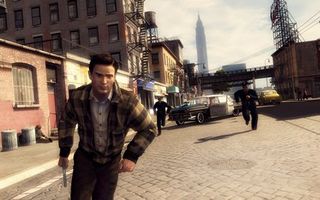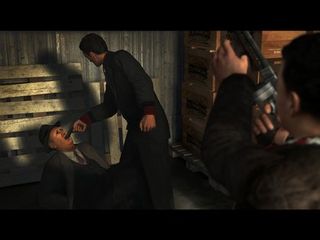Mafia II - first look
Slick visuals and stylish mobsters make this 1950s mob drama one to watch
Part of the challenge will no doubt come from the cops, who - like in the original Mafia - will pay attention to every little infraction you commit. Run a red light or speed in front of one, and they'll be after you in a second. It's unlikely that they'll be quite as tenacious as the cops in the first game, though, as they'll decide how badly they want to go after you based on the severity of your crimes (which also means you're less likely to get shot for punching one of them). They'll also target anyone else they see breaking the law, meaning you won't be the only one getting arrested all the time.

When you're cornered by cops (or just need to kick some ass in general), Mafia II will feature cover-centric gunplay - complete with the ability to blind-fire or aim from behind cover - that should be a lot more robust than the point-and-click combat of the original. Not to say everything will make good cover, though; much of the game world will be destructible, so things like crates or thin walls won't protect you for long - if at all.
Being as you're a mobster, though, it's likely you'll need to bust teeth a lot more often than you'll bust caps. To that end, the developers are looking at a system whereby you'll be able to learn new close-quarters moves and combos, turning Vito into an even more formidable badass as he climbs the criminal ladder.

Reallly, though, it's the detail that sets Mafia II apart. Pains have been taken to make everything in the game, from household appliances to massive landmarks, look like they would in the '40s and '50s. In fact, Vavra said, "everything in the game has its real, contemporary counterpart."
"We have a library of thousands of pictures of buildings, cars, machines, people, cities," Vavra continued. "Even if we wanted to be more accurate than we are now, I doubt it would be possible."
What's more, all those bits of vintage detail will actually work. Folks on the sidewalk will act like real people, talking, smoking and doing their own thing independent of you. Walk into one of the game's interiors - seamlessly linked with the outside world - and you'll be able to turn the lights on and off, use the sink, kick around some furniture or pick up a bottle to use as a weapon. You'll also be able to listen to radios indoors or in your car, featuring period-appropriate licensed music, DJs and reporters who'll react to changes and events in the game world.

Some of the subtler touches serve a more practical purpose. For example, cars have working trunks, which can be used to stash weapons or - in a pinch - bodies. Also, in a move seemingly borrowed from GTA IV, Mafia II will feature taxis that can be used as rapid transport to anywhere in the city instead of just a quick, jackable ride.
Sign up to the GamesRadar+ Newsletter
Weekly digests, tales from the communities you love, and more
In spite of all the ridiculous levels of detail, though, Mafia II - like the original game - will focus more on telling a linear story than on open-world freedom. "From the very beginning of this project," Vavra said, "we decided as a team that our strength lies in our ability to tell an intense, gripping story with deep believable characters."

"However, with that said, within the constraints of telling a compelling story creates, we give the gamer as much freedom as possible," Vavra said. "For example, missions can be completed in various ways, and sometimes even the story will be influenced by some of the choices the gamer makes during the course of the game." He then added that there will be a lot more side missions, interactive locations and other cool additions this time around to distract players from the central mission structure.
Whatever the case, Mafia II already looks incredible. Assuming it plays that way - and assuming the story is at least as good as the original - this retro mob tale could be exactly what crime fans need when the luster starts wearing off of GTA IV. Without a solid release date, it's hard to say for sure, but we'll be keeping a close eye on this one.
Apr 9, 2008

Stellar Blade director jokes the action RPG "is the outcome of my creative dictatorship," but "everyone pretends to listen to what I say whilst creating what they want"

I wish Stellar Blade's New Game+ was added before my first playthrough, because it sounds like a whole new action RPG with 34 new outfits and a bigger skill tree
Most Popular




